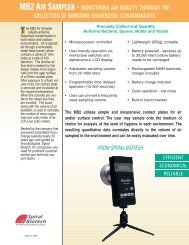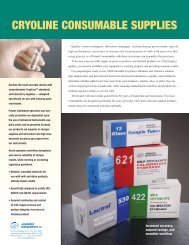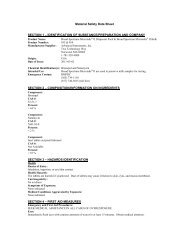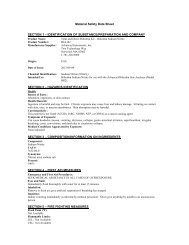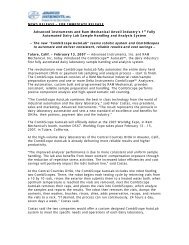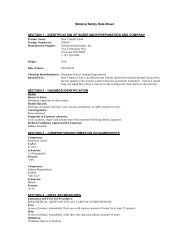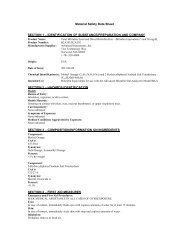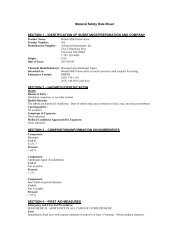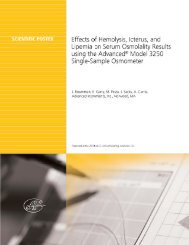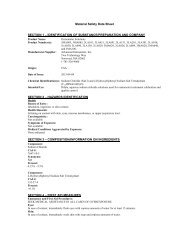Download - Advanced Instruments, Inc.
Download - Advanced Instruments, Inc.
Download - Advanced Instruments, Inc.
You also want an ePaper? Increase the reach of your titles
YUMPU automatically turns print PDFs into web optimized ePapers that Google loves.
Vol. 2 No. 1<br />
<strong>Advanced</strong> Analysis for the Dairy industry<br />
in this<br />
ISSUE<br />
FEATURES<br />
Model 4250 Cryoscope<br />
sets new standard for<br />
dairy industry 1<br />
Calculated freezingpoint<br />
depression versus<br />
cryoscopy 2<br />
Quality control in<br />
cheesemaking 4<br />
EVERY ISSUE<br />
From the president 2<br />
Frequently asked<br />
questions 3<br />
Did you know?<br />
It’s ciao time in Vermont 3<br />
Upcoming events 4<br />
Technical support 4<br />
Model 4250<br />
Cryoscope sets<br />
new standard for<br />
dairy industry<br />
<strong>Advanced</strong> <strong>Instruments</strong>,<br />
a leading laboratory<br />
instrument provider to<br />
the food and dairy industry,<br />
introduced its <strong>Advanced</strong>® Model<br />
4250 Single-Sample Cryoscope in<br />
October 2005 at the Worldwide<br />
Food Expo in Chicago. The<br />
diagnostic instrument, which<br />
“The Model 4250 sets the standard<br />
for precision, accuracy, and ease of use. With its capability to test<br />
cow, goat, sheep, and buffalo milk, this flexible instrument is ideal<br />
for all dairy processors, including specialty milk producers.”<br />
The 4250 uses the<br />
industry-preferred<br />
freezing point method<br />
to precisely determine<br />
added water in milk.<br />
<strong>Advanced</strong> Dairy News is an<br />
<strong>Advanced</strong> <strong>Instruments</strong>, <strong>Inc</strong>.<br />
publication. Copyright © 2006<br />
<strong>Advanced</strong> <strong>Instruments</strong>, <strong>Inc</strong>.<br />
All rights reserved.<br />
dairy labs use to measure the water content in<br />
milk, incorporates new design and electronic<br />
technologies that enhance usability, accuracy,<br />
and reliability.<br />
“The Model 4250 sets the standard for<br />
precision, accuracy, and ease of use,” said Ken<br />
Micciche, Director of Marketing, <strong>Advanced</strong><br />
<strong>Instruments</strong>. “It builds on our heritage of<br />
leadership and value by incorporating advanced<br />
electronic technologies and a new highly<br />
functional design. With its capability to test<br />
cow, goat, sheep, and buffalo milk, this flexible<br />
instrument is ideal for all dairy processors,<br />
including specialty milk producers.”<br />
The single-sample cryoscope includes new<br />
features that enhance usability and make it easy<br />
to update: multiple language capability, onboard<br />
printer, stored test results for later recall,<br />
and downloadable software upgrades.<br />
“Our new cryoscope’s proven, reliable<br />
technology, plus 24/7 technical support, make it<br />
a perfect fit for dairy processors requiring highly<br />
dependable, accurate verification of water levels<br />
in their milk products,” said Micciche.<br />
The Model 4250 is available for immediate<br />
delivery from <strong>Advanced</strong> <strong>Instruments</strong> and its<br />
distributors.
CalculatedFreezing Point Depression<br />
VersusCryoscopy<br />
from the<br />
PRESIDENT<br />
Welcome to our latest<br />
edition of <strong>Advanced</strong> Dairy<br />
News, where we continue<br />
our tradition of providing<br />
specific product and<br />
application information<br />
geared towards improving<br />
your dairy lab operations.<br />
Our company is dedicated<br />
to your industry and we<br />
constantly re-invest our<br />
profits to develop new<br />
products for you.<br />
This issue features<br />
information on our newest<br />
cryoscope, the Model 4250<br />
and an informative article<br />
explaining the differences<br />
between calculated and<br />
measured freezing point.<br />
The issue of pasteurization<br />
and food safety as it relates<br />
to cheese is also examined.<br />
We value your input and<br />
comments —please feel free<br />
to share <strong>Advanced</strong> Dairy<br />
News with your colleagues.<br />
John Coughlin, President<br />
<strong>Advanced</strong> <strong>Instruments</strong>, <strong>Inc</strong>.<br />
The analysis of milk and dairy<br />
products is usually performed on<br />
infrared spectrometers such as the Delta<br />
Lactoscope FTIR. Infrared analyzers<br />
feature a low cost per test and are easily<br />
automated, making them attractive<br />
to high volume testing labs. These<br />
modern instruments offer precise, reliable<br />
determination of fat, protein, lactose, nonprotein<br />
nitrogen and many other components<br />
of interest.<br />
In recent years, infrared milk analyzers<br />
have added freezing point depression to<br />
their growing list of capabilities. Utilizing<br />
optional hardware and software, the<br />
analyzer can calculate the apparent freezing<br />
point of the milk sample using the fat, protein<br />
and lactose information together with a<br />
measurement of the electrical conductivity of the<br />
sample. This capability takes advantage of the<br />
analyzer’s high-speed automated capability and<br />
minimizes the need for a separate measurement<br />
on a dedicated cryoscope.<br />
Many users have asked how calculated<br />
freezing point depression compares with the<br />
standard cryoscope method. In this article we’ll<br />
compare the two. Freezing point depression<br />
of milk is measured to determine if water has<br />
been added. Normal whole milk will have a<br />
freezing point in the range of -530 to -540<br />
milli °C. In other words, the freezing point<br />
of milk is lower than that of pure water (water<br />
freezes at 0°C, this is why the term “freezing<br />
point depression” is used; the milk freezing point<br />
is “depressed” relative to that of pure water). If<br />
water has been added to the milk, it will raise the<br />
freezing point of the sample. For example, a value<br />
of -520 °C would definitely indicate that added<br />
water is present.<br />
The <strong>Advanced</strong> ® Delta <strong>Instruments</strong> FTIR<br />
LactoScope calculates freezing point<br />
using infrared analysis.<br />
A cryoscope makes a direct, accurate<br />
measurement of freezing point by actually<br />
freezing the sample. The cryoscope is the only<br />
internationally accepted direct method for making<br />
this measurement.<br />
Cryoscopes are accurate to plus or minus 2<br />
milli °C. They can be calibrated using precision<br />
NIST traceable salt-water reagents with very<br />
accurate freezing points and the basic instrument<br />
(continued on next page)<br />
2<br />
The quickest and most precise way to measure the<br />
freezing point of a solution is to supercool it several degrees<br />
below its freezing point, then mechanically induces the<br />
sample to freeze. The heat of fusion suddenly liberated<br />
causes the sample temperature to rise toward a plateau<br />
wherein the intrinsic sample thermodynamics maintain<br />
a temporary adiabatic liquid/solid equilibrium. The time<br />
over which equilibrium develops and is maintained is a<br />
function of the thermal characteristics of the sample —<br />
the temperature differential between the sample and its<br />
environment and the ability of the intervening materials to<br />
conduct heat. The equilibrium temperature is the freezing<br />
point of the solution.<br />
Standard curve illustrates the principle of freezing<br />
point measurement
frequently asked<br />
questions<br />
How can I keep my<br />
cryoscope in good<br />
working condition?<br />
Be sure to clean and replace the<br />
air filters often. Poor air flow<br />
can cause the cooling assembly<br />
to fail prematurely and produce<br />
“Test Time Out” errors,<br />
extending the time needed to<br />
complete a test. Power supplies<br />
can also fail prematurely if there<br />
is an insufficient air supply.<br />
When should I replace<br />
my heat-transfer fluid?<br />
You should replace your bottle<br />
of heat-transfer fluid when the<br />
fluid level drops to the line on<br />
the bottle label, or one month<br />
after the bottle is opened. Do<br />
not pour old heat transfer fluid<br />
between bottles. This will cause<br />
moisture and growth build<br />
up from the old bottle to be<br />
transferred into the new sample<br />
of heat transfer fluid, thus<br />
reducing the life of the heat<br />
transfer.<br />
How can I use automated<br />
evaluation to check for the<br />
presence of bacteria in milk<br />
and milk products?<br />
The BacTrac impedance<br />
analyzer is perfect for the<br />
detection of bacteria, yeasts,<br />
and molds in milk and milk<br />
products. Automated evaluation<br />
of presence-absence is possible<br />
by setting a detection limit. The<br />
limit is set and then monitored<br />
over a pre-determined duration<br />
of measurement. Positive<br />
samples change to red on the<br />
screen when the threshold<br />
is reached; negative samples<br />
appear green at the end of the<br />
measurement.<br />
Calculated freezing point depression versus cryoscopy<br />
(continued from page 2)<br />
FTIR analysis determining the amount of fat,<br />
lactose, and solids content.<br />
Calculated freezing<br />
point depression is not as<br />
accurate as a cryoscope;<br />
typically it’s in the range<br />
of +/- 6 milli °C.<br />
did you<br />
know?<br />
If you’re ever in Woodstock, Vermont and<br />
see some water buffalo, there’s a tasty reason<br />
why they’re present.<br />
Several years ago David Muller, a<br />
former Boston business executive, founded<br />
Woodstock Water Buffalo Company, a<br />
dairy dedicated to supporting sustainable<br />
agriculture and the family farm.<br />
Every morning he walks to the barn<br />
is reliable and trouble-free. The<br />
downside of cryoscopes is that they<br />
require anywhere from 2 to 3 minutes<br />
per test. Automated versions are<br />
available with testing capabilities of<br />
40 samples per hour; a far cry from<br />
the 400 samples per hour typical of<br />
modern infrared analyzers and far<br />
too slow for high volume automated<br />
testing labs.<br />
Infrared analyzers use a derived<br />
formula to calculate freezing point<br />
depression. A Dutch dairy scientist<br />
named Koops developed the formula.<br />
The method depends on the electrical conductivity of the sample, measured with a<br />
separate flow cell, and the measurements of fat, protein and lactose that are available from<br />
the infrared analyzer. The method assumes that the fat and lactose are within normal<br />
ranges. This “calculated” freezing point is an empirical method, not a direct measurement.<br />
Calculated freezing point depression<br />
is not as accurate as a cryoscope;<br />
typically it’s in the range of +/-<br />
6 milli ° C. Calibration is not<br />
possible using precision cryoscope<br />
reagents because these don’t contain<br />
fat, protein or lactose, necessary<br />
parameters for the empirical<br />
formula. Instead, an actual milk<br />
sample is used by measuring its<br />
freezing point on a cryoscope and<br />
then using the same sample to<br />
calibrate the infrared analyzer. The cryoscope therefore becomes the reference standard.<br />
At this time there are no national or international standards pertaining to acceptance of<br />
calculated freezing point.<br />
Properly calibrated and maintained, calculated freezing points from the infrared<br />
analyzer will correlate well with the measured results from a cryoscope. Therefore high<br />
volume testing facilities can screen all of their samples for freezing point depression, a<br />
capability that’s impossible given the slow speed of a cryoscope. When the calculated<br />
results differ significantly from normal ranges, it is probable, but not guaranteed, that<br />
added water is present. In these situations, most users opt to confirm the deviations with a<br />
manual cryoscope measurement, especially if the data are to be used as a basis for rejecting<br />
the milk.<br />
it’s Ciao Time in Vermont<br />
sheltering more than 50 Southeast Asian<br />
water buffalo, each about the size of a<br />
compact automobile. These warm-weather<br />
animals, never before domesticated in New<br />
England, now produce large quantities<br />
of milk. WWBC mozzarella is sold in<br />
restaurants and gourmet retail markets,<br />
–the cheese sells for about $16 a pound,<br />
(continued on page 4)<br />
3
did you know?<br />
it’s Ciao Time in Vermont<br />
(continued from page 3)<br />
roughly the same price as mozzarella from Italy.<br />
To assure authenticity, mozzarella maker Vincenzo<br />
Ferraro, 36, from the Campania region of southern Italy<br />
was hired. Vincenzo paces the lab while instructing<br />
Vermonters in the art of turning buffalo milk into perfect<br />
mozzarella cheese.<br />
Buffalo milk is pure white because it contains no<br />
carotene — the buffalo have already processed the<br />
carotene into Vitamin A. Buffalo milk is also very thick,<br />
more like half-and-half than milk.<br />
Measurable differences lie in the nutritional value of<br />
buffalo milk – it contains 8% to 10% fat, cow’s milk has<br />
roughly 4% fat. Buffalo milk has 58% more calcium,<br />
40% more protein, and 43% less cholesterol than cow’s<br />
milk, and contains high levels of the natural antioxidant<br />
tocopherol. Perhaps<br />
the biggest difference<br />
get this in<br />
your email<br />
Visit www.aicompanies.com/<br />
dairynews today to register for<br />
your free electronic copy.<br />
- typical cows gives<br />
milk for three to four<br />
years, while a water<br />
buffalo will produce<br />
for 12 to 14 years.<br />
<strong>Advanced</strong> Analysis for the Dairy industry<br />
upcoming<br />
EVENTS<br />
International Dairy<br />
Federation<br />
April 30 - May 3, 2006<br />
Vilnius, Lithuania<br />
IFT (Institute of Food<br />
Technologists<br />
June 25 - 27, 2006<br />
Orlando, Florida<br />
IAFP (International<br />
Association for Food<br />
Protection)<br />
August 13 - 16, 2006<br />
Calgary, AB, Canada<br />
do you meet recent requirements?<br />
Quality control in cheesemaking<br />
In the early days of milk pasteurization, the<br />
only tests available were based on colorimetric<br />
chemistry. These tests were blunt tools which<br />
could measure about 0.1% raw milk in the<br />
pasteurised product.<br />
In recent years a more precise, more sensitive<br />
and more reproducible test – The Fluorophos®<br />
method - has found widespread use in<br />
pasteurization plants. The Fluorophos, which is 20<br />
times more sensitive than previous test methods, is<br />
widely used to control pasteurization plants.<br />
There is now growing interest in differentiating<br />
cheeses made from raw and pasteurized milk.<br />
There are two very different objectives behind the<br />
interest.<br />
The first is based on food safety grounds.<br />
We know that raw milk can contain pathogens<br />
which can survive the cheesemaking process<br />
and proliferate in cheeses where the pH favours<br />
growth. The issue of listeria monocytogenes<br />
(a pathogen found in raw milk) in mold ripened<br />
raw milk soft cheeses was raised some years ago.<br />
The organism was reported to have been the cause<br />
of abortions<br />
and expectant<br />
mothers were<br />
advised not<br />
to eat such<br />
cheeses. There<br />
have also been<br />
food poisoning<br />
outbreaks associated with raw milk cheese<br />
consumption. This has lead to many countries<br />
requiring raw milk cheeses to be clearly labelled.<br />
The second interest is commercial. In part<br />
two of this article we will discuss implications<br />
for cheese import regulators, legislators and<br />
supermarkets.<br />
by Frank Harding O.B.E., Formally Technical Director of the<br />
Milk Marketing Board of England and Wales.<br />
technical<br />
support<br />
Technical Support is available around the clock for all <strong>Advanced</strong> <strong>Instruments</strong>, Fiske ® Associates, and Spiral Biotech<br />
customers. Call toll free —(800) 225-4034 or +1 (781) 320-9000, extension 2191, or FAX: +1 (781) 320-8181.<br />
Email us at techsupport@aicompanies.com.<br />
24-Hour Support, 7 Days a Week




